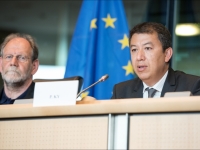Politics
European Commission and EASA discussed how to prevent disasters as Germanwings
A task force will be created
USPA NEWS -
The Germanwings disaster in the French Alps on 24 March raised important questions about air safety after investigators discovered the co-pilot has intentionally crashed the plane, killing 150 people. The transport committee of the European Parliament discussed on 29 June how to prevent this.
The European Commission and Patrick Ky, executive director of the European Aviation Safety Agency (EASA) discussed the recommendations of an EASA task force dedicated to the crash. Transport commissioner Violeta Bulc asked EASA to establish a task force to assess the preliminary investigation report on the causes of the crash by the French Civil Aviation Safety Investigation Authority. In addition to people from EASA, the task force consists of several experts, including representatives from national authorities, airlines, pilot associations, medical doctors, airlines' health services and training organisations.
The task force is expected to produce a report with recommendations at the end of July, after which the European Commission will have to decide whether to update aviation safety rules. EASA head Patrick Ky presented the work of the task force at the meeting of the transport committee on 29 June, which was opened by chair Michael Cramer, a German member of the Greens/EFA group.
"Reinforced cockpit doors were implemented in the aftermath of September 11," Ky said. "We are [also] having a thorough look at medical checks, the initial and continuous assessment of pilots, psychological tests, drugs and alcohol testing and also a system for better sharing of medical data. We also want to have a look at the work environment of pilots."
MEPs questioned EASA's executive director on what the next steps would be. Romanian EPP member Marian-Jean Marinescu asked how these recommendations could be made mandatory, while Latvian ECR member Roberts ZÄ«le wanted to know how we can ensure that these recommendations would not lead to other dangerous situations. On 27 March, when it had already become clear that the crash had been intentional, EASA published a recommendation to have at least two people in the cockpit at all times, known as the four eyes principle. German S&D member Ismail Ertug welcomed the idea and wondered if it would not make sense to make this mandatory by law.
Liability for this article lies with the author, who also holds the copyright. Editorial content from USPA may be quoted on other websites as long as the quote comprises no more than 5% of the entire text, is marked as such and the source is named (via hyperlink).






